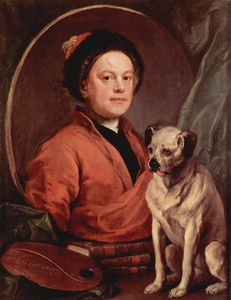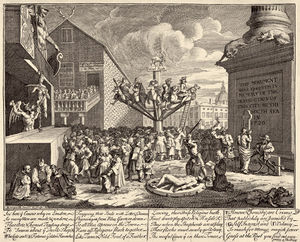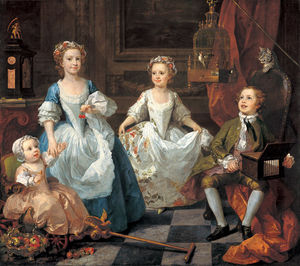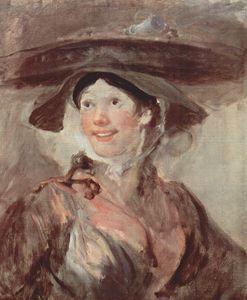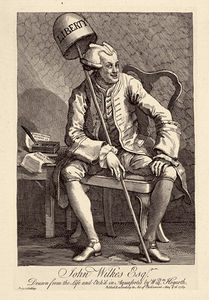William Hogarth Biography
- Full Name:
- William Hogarth
- Short Name:
- Hogarth
- Date of Birth:
- 10 Nov 1697
- Date of Death:
- 26 Oct 1764
- Focus:
- Paintings
- Mediums:
- Oil, Prints, Wood, Other
- Subjects:
- Figure, Scenery
- Art Movement:
- Rococo
- Hometown:
- London, United Kingdom
- William Hogarth Biography Page's Content
- Early Years
- Middle Years
- Advanced Years
William Hogarth Early Years
Born the son of Richard Hogarth and Ann Gibbons on 10th November 1697, William was the fifth child of the family. His father was a classically trained school master specializing in Latin and his family very much relied on him as the main breadwinner. However, by 1707, an unprofitable coffeehouse business set up by Richard left him in Fleet Prison for debt. He remained there until 1712 and unfortunately, died only a few years later in 1718.
To earn some money, William Hogarth started an apprenticeship with Ellis Gamble in 1713 as a plate engraver and by 1720 he had his own independent plate engraving business.
Through this work Hogarth met with the artist Sir James Thornhill and was a regular attendee at Thornhill's art academy based in Covent Garden.
Hogarth's time there was his only formal training in art and during this period he produced his most prized work, of a series of illustrations of Samuel Butler's 'Hudibras'.
During the 1720s Hogarth continued to make a series of engravings of scenes from popular theatre shows, demonstrating the earliest signs of the satirical work to come. Works such as The South Sea Scheme and The Lottery, both produced in 1721, show Hogarth's wit and both pieces were helped establish Hogarth's reputation as an artist in London.
William Hogarth Middle Years
From 1731 onwards, Hogarth produced what was to become known as his 'modern morality paintings. These were specifically designed to be copied in large numbers and sold as prints to members of the public. The most well-known series' are A Harlot's Progress and A Rake's Progress.
These prints proved to be very popular and went on to be reprinted. A Harlot's Progress was even made into a pantomime.
William Hogarth had summer lodgings in South Lambert and while holidaying there he met Jonathan Tyers, a man trying to re-open New Spring Gardens at Vauxhall for entertainment events. Tyers asked Hogarth to decorate the interior of the place and the series of paintings he produced, Four Times of the Day, depicted different aspects of London life.
As Hogarth's engravings became popular they were regularly copied and sold on without his permission. Hogarth used his parliamentary contacts to encourage a Copyright Act of 1735 and this made copying work without permission illegal.
Between 1740 and 1745 Hogarth focused on portraits and received commissions from the rich and influential elite of London society. Portraits of The Graham Children and Captain Coram are particularly skillful. However, it is in Hogarth's sketches such as The Shrimp Girl and Heads of Six of Hogarth's Servants that he really excels.
In 1748 Hogarth created The Roast Beef of Old England after an eventful trip to the French port of Calais. After entering the port as a tourist the artist began sketching the fortifications. This drew the attention of the French police who accused him of being a spy.
On his return to England Hogarth painted less than flattering political paintings about the French, perhaps reaffirming his distaste for the continent.
Hogarth was at the height of his career at this point and was making a good living from his printed works and portraiture. He then tried his hand at historical painting but this venture wasn't very successful and he received a lot of criticism for attempting something which many of his contemporaries believed was above him.
William Hogarth Advanced Years
In 1757 Hogarth's brother-in-law resigned as sergeant painter to the court and Hogarth took the role accordingly.
In 1762 Hogarth published an anti-war satire 'The Times' which caused outrage from one prominent MP in particular, John Wilkes. He published a scathing article dismissing Hogarth's work in his newspaper The North Briton.
In response Hogarth created an engraving, John Wilkes Esq. showing the MP wearing a symbolic cap of liberty in such a way that it appears to be a halo along with a wig shaped like horns.
In July 1673, not long after printing the John Wilkes Esq. engraving, Hogarth suffered from a paralytic seizure and became seriously ill. He passed away in London in 1764 at the age of 67 and is buried in Chiswick cemetery. He left no children.

